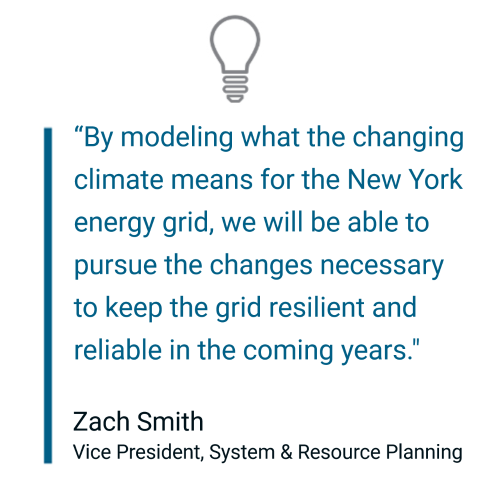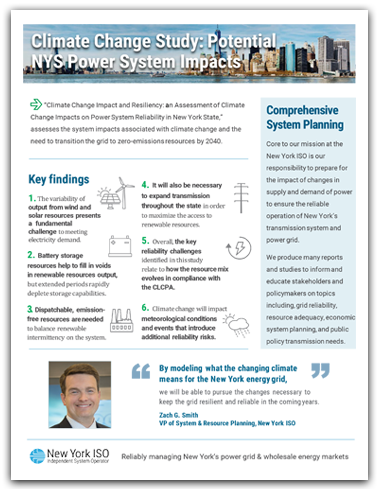New Climate Change Study Examines Resilience and Reliability of New York Energy Grid
As New York State advances climate and energy policies in pursuit of a cleaner, more resilient grid, we continue to examine long-range scenarios to assess impacts on grid reliability.
The goal is to determine what competitive wholesale electricity market modifications will attract the types of resources necessary to meet future system needs.
We released the Climate Change Impact and Resilience Study - Phase II, which reviews the potential power system reliability impacts expected in 2040. This study, nine months in the making by the Analysis Group, looks at several models of energy demand, including the expected impacts of the Climate Leadership and Community Protection Act, or CLCPA.
Electrifying changes ahead
The CLCPA requires 70% of our energy to come from renewable resources by 2030, a zero-emission grid by 2040, and 85% reduction in economy-wide greenhouse gas emissions by 2050. Reaching the 2050 goal will require significant investment in electric vehicles and electric building heat, which will increase the amount of power needed in the state. We call this “electrification.” The growth of electrification is expected to turn New York’s peak demand from summer, when air conditioner use is highest, to winter, when greater amounts of electrified building heat will require more electricity to run.
Many questions remain about the grid of the future, such as what will power the grid beyond 2040, or what role will energy storage take in providing power? And the expected growth of wind and solar resources to meet the CLCPA mandate creates its own questions:
- Where will the energy come from on high-demand days when the sun isn’t shining and the wind has lulled?
- What will be the impact on the grid from a greater number of heat waves or extended cold snaps?
- How resilient will the system be in the face of more frequent and intense winter or summer storms?
“Grid planning has always been an essential part of grid management, and the Climate Change Impact and Resilience Study is an important tool that will help policymakers assess future needs while helping us refine our markets to attract the investment necessary to support a reliable grid," said Zach Smith, Vice President, System and Resource Planning.
Study Findings
- A greater reliance on solar and wind power, including offshore wind, presents a fundamental challenge. The study found that periods of reduced output from wind and solar resources challenge system reliability conditions, especially during wind lulls. One model of a 13-hour winter wind lull, based on actual historical weather data, forecasted a loss of more than 14,000 MW (megawatts). The study also noted that solar power would not contribute to the expected daily energy peaks in winter, which would occur in the evening after the sun has set.

Climate Change Study Datasheet - Battery storage could make up some of this void but extended periods of reduced renewable generation would rapidly deplete such resources. While one model of the grid in 2040 shows more than 15,600 MW of new storage resources, these resources would be drained if solar and wind power was significantly reduced for more than a day due to weather conditions.
- What is needed to fill in the gap are energy resources that are both flexible (able to provide energy on demand) and clean. These resources must be significant in capacity, be able to come on line quickly, and be flexible enough to meet energy needs rapidly.
- It will also be necessary to increase transmission around the state in order to maximize the contribution of renewable resources, which are mostly located upstate. However, the increased reliance on moving power from region to region also increases vulnerability of the system in the face of severe weather events.
- Overall, the key reliability challenges identified in this study relate to how the resource mix evolves in compliance with the CLCPA, and the impact of climate change on meteorological conditions and events that introduce additional reliability risks.
For more, read the Climate Change Impact and Resilience Study and its appendices, visit the NYISO Power Systems Information and Outlook webpage.
Download the Climate Change Study datasheet.

